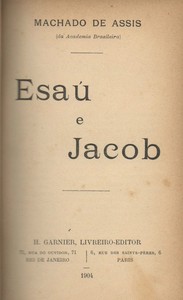| Author |
Machado de Assis, 1839-1908 |
| Title |
Esau e Jacob
|
| Note |
Reading ease score: 56.0 (10th to 12th grade). Somewhat difficult to read.
|
| Note |
Wikipedia page about this book: https://en.wikipedia.org/wiki/Esau_and_Jacob_(novel)
|
| Credits |
Produced by Laura Natal Rodrigues & Marc D'Hooghe at Free Literature
|
| Summary |
"Esau e Jacob" by Machado de Assis is a novel written in the late 19th century. The book explores complex themes of fate, identity, and the dualities of human nature through the intertwined lives of two pairs of identical twins, Esau and Jacob. Set against the backdrop of Brazilian society, it delves into the characters' struggles for greatness and the inevitability of conflict inherent in sibling relationships. At the start of the narrative, we are introduced to Natividade and Perpetua, two women venturing up to the Morro do Castelo in Rio de Janeiro, seeking the famed fortune-teller known as the "cabocla." The visit is marked by their apprehensions and the growing anticipation of the predictions about Natividade’s twin sons, Pedro and Paulo. The cabocla hints that the boys were destined for greatness, though she also alludes to a significant conflict that occurred even before their birth—a rivalry that sets the stage for exploring themes of sibling tension and destiny throughout the novel. The merge of superstition and everyday life in the characters' experiences begins to unfold, hinting at the deeper philosophical inquiries to follow. (This is an automatically generated summary.)
|
| Language |
Portuguese |
| LoC Class |
PQ: Language and Literatures: Romance literatures: French, Italian, Spanish, Portuguese
|
| Subject |
Rio de Janeiro (Brazil) -- Fiction
|
| Category |
Text |
| EBook-No. |
56737 |
| Release Date |
Mar 14, 2018 |
| Copyright Status |
Public domain in the USA. |
| Downloads |
117 downloads in the last 30 days. |
|
Project Gutenberg eBooks are always free!
|

